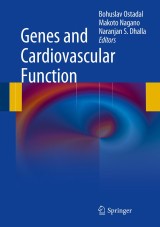Details

Genes and Cardiovascular Function
|
CHF 130.00 |
|
| Verlag: | Springer |
| Format: | |
| Veröffentl.: | 09.08.2011 |
| ISBN/EAN: | 9781441972071 |
| Sprache: | englisch |
| Anzahl Seiten: | 264 |
Dieses eBook enthält ein Wasserzeichen.
Beschreibungen
<p>Rapid advances in molecular medicine have led to pronounced new developments in experimental and clinical cardiology. In the embrace of modern molecular biology and bridging the gap between the clinical and the genomic, cardiovascular medicine has seen major strides in the understanding of the molecular mechanisms that drive disease progression. The ability to rapidly identify candidate human genes for cardiovascular diseases lends itself to the development of diverse strategies for disease treatment and management. The wide variety of gene expressions proffers excellent targets for novel therapeutics. Gene therapy is steadily increasing in viability and represents a fascinating arena of research and clinical focus.</p><p> </p>This book is based on two international Mendel symposia on “Genes and the Heart,” joint meetings of the Japanese and European sections of the International Academy of Cardiovascular Sciences. Highlighting selected symposia contributions, this book explores the role of molecular biology and genetics in the basic knowledge, genesis, and clinical interventions of cardiovascular diseases.
<p>A. Genes and the Heart</p><p><i> </i></p><p>1. Johann Gregor Mendel “Father of modern genetics”</p><p><i> P. Braveny </i></p><p> </p><p>2. Gene therapy: hopes and problems</p><p><i> V. Vonka</i></p><p> </p><p>B. Development and Gender</p><p> </p><p>3. VEGFs, FGFs and PDGF coordinate embryonic coronary vascularization</p><p><i> </i><i>R.J. Tomanek, L.P. Christensen </i></p><p> </p><p>4. The E2F pathway in cardiac development and disease</p><p> <i>J. Rueger, B.S. Tuana </i></p><p> </p><p>5. Cardiac sodium-calcium exchanger expression</p><p> <i>C. Hurtado, T.G. Maddaford, G.N. Pierce </i></p><p> </p><p>6. Scleraxis: a new regulator of extracellular matrix formation</p><p> <i>R.A. Bagchi, M.P. Czubryt</i></p><p> </p><p>7. Gender impact on pathophysiology of the heart</p> <i>J-L. Samuel, C. Delcayre, B. Swynghedauw</i><p> </p><p>C. Mitochondrial Diseases</p><p> </p><p>8. Mitochondrial DNA and heart disease</p><p> <i>C. Shikata, M. Nemoto, T. Ebisawa, A. Nishiyama, N. Takeda</i></p><p> </p><p>9. A novel algorithm from personal genome to the pathogenic mutant causing mitochondrial cardiomyopathy</p><p> <i>T. Toyo-oka, T. Tanaka, L. Toyo-oka, K. Tokunaga</i></p><p> </p><p>10. MELAS Syndrome: mediated by impaired taurinomethyluridine synthesis</p><p> <i>S. Schaffer, C. Ju Jong</i></p><p> </p><p>D. Ischemic Heart Disease</p><p> </p><p>11. Genetics of myocardial infarction</p><p> <i>R. Poledne, J.A. Hubacek</i></p><p> </p><p>12. Genetic background of myocardial infarction</p><p> <i>K. Ozaki, T. Tanaka </i></p><p> </p><p>13. I/D ACE polymorphism and cardiovascular risk: disclosed story</p><p> <i>A. Vasku, J. Blahak, D. Baumgartner, J. B. Vasku</i></p><p> </p><p>14. PPARs and myocardial response to ischemia in normal and diseased heart</p><p><i>T. Ravingerova, A. Adameova, S. Carnicka, T. Kelly, M. Nemcekova, J. Matejikova,</i></p><p><i> A. Lazou</i></p><p><i> </i></p><p>15. Genes and plasma lipids in Czech Slavic population</p><p> <i>J.A. Hubacek, R. Poledne</i></p><p> </p><p>E. Hypertension and Arrhythmias</p><p> </p><p>16. Genetic basis of salt-sensitive hypertension in humans</p><p> <i>F.H.H Leenen, Md.S. Amin, A.F.R. Stewart, F. Tesson</i></p><p> </p><p>17. Gene-environment interactions: their role in hypertension development</p><p><i> J. Kunes, M. Kadlecova, J. Zicha</i></p><p> </p><p>18. Phenotypic overlap of lethal arrhythmias associated with cardiac sodium mutations: Individual-specific or mutation-specific?</p><p> <i>N. Makita </i></p><p> </p><p>F. Hypertrophy and Failure</p><p> </p><p>19. CLP-1 mediated transcriptional control of hypertrophic gene programs underlying cardiac hypertrophy</p><p> <i>M.A.Q. Siddiqui, M. Wagner, J. Espinoza-Derout, F. Huang, D. Beckles, E. Mascareno </i></p><p> </p><p>20. Molecular mechanisms of subcellular remodeling in congestive heart failure</p><p> <i>A.P. Babick, A.L. Müller, N.S. Dhalla </i></p><p> </p><p>21. Cardiomyopathy, sarcomeropathy and Z-discopathy</p><p> <i>A. Kimura</i></p><p> </p><p>22. Left ventricular assist device: morphological, molecular and genetic changes after mechanical support</p><p> <i>H.A. Baba, A. Takeda, N. Takeda, J. Wohlschlaeger</i></p><p> </p><p>23. Vascular Ehlers-Danlos syndrome: a good experimental model is needed for development of treatment strategies</p><p> <i>W. Briest, M.I. Talan</i></p><p><i> </i></p><p>24. Multi-scale, multi-physics heart simulator as a tool to link bench and bedside</p><p> <i>S. Sugiura, T. Washio, J. Okada, H. Watanabe, T. Hisada</i></p><p>
<p>Rapid advances in molecular medicine have led to pronounced new developments in experimental and clinical cardiology. In the embrace of modern molecular biology and bridging the gap between the clinical and the genomic, cardiovascular medicine has seen major strides in the understanding of the molecular mechanisms that drive disease progression. The ability to rapidly identify candidate human genes for cardiovascular diseases lends itself to the development of diverse strategies for disease treatment and management. The wide variety of gene expressions proffers excellent targets for novel therapeutics. Gene therapy is steadily increasing in viability and represents a fascinating arena of research and clinical focus.</p><p> </p>This book is based on two international Mendel symposia on “Genes and the Heart,” joint meetings of the Japanese and European sections of the International Academy of Cardiovascular Sciences. Highlighting selected symposia contributions, this book explores the role of molecular biology and genetics in the basic knowledge, genesis, and clinical interventions of cardiovascular diseases.
<p>Bridges the gap between clinical cardiology and genomic study</p><p>Explores the role of genes in cardiac development</p><p>Provides a genomic approach to the treatment of the wide spectrum of cardiovascular diseases</p><p>Written by established investigators, representing the world’s leading experts in the field</p><p>Includes supplementary material: sn.pub/extras</p>
Diese Produkte könnten Sie auch interessieren:

Razum prestupnika i logika prestupleniya. O psihiatrii, sudah i seriynyh ubiytsah

von: Shohom Das, Dmitry Chepusov

CHF 7.00

















